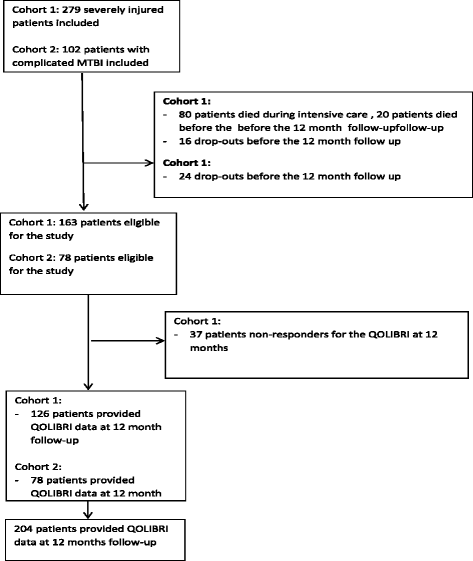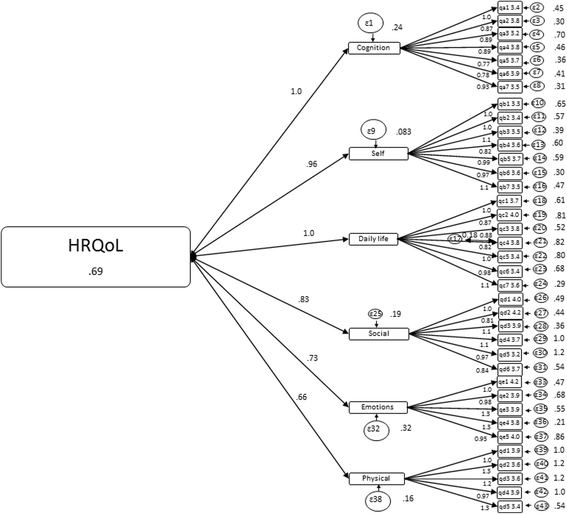The Norwegian version of the QOLIBRI - a study of metric properties based on a 12 month follow-up of persons with traumatic brain injury
- PMID: 28103876
- PMCID: PMC5248455
- DOI: 10.1186/s12955-017-0589-9
The Norwegian version of the QOLIBRI - a study of metric properties based on a 12 month follow-up of persons with traumatic brain injury
Abstract
Background: Consequences after Traumatic brain injury (TBI) affect the injured person's self-image and quality of life. The purpose was to assess the health related quality of life (HRQoL) at 12 months after a TBI in patients admitted to regional trauma centres, and to evaluate the metric properties of the Norwegian version of the Quality of Life After Brain Injury (QOLIBRI) questionnaire.
Methods: Two hundred four patients with TBI of all severities were included. HRQoL at 12 months post-injury was measured by the QOLIBRI. It has a total scale and 6 subscales (satisfied with Cognition, Self, Daily Life and Autonomy and Social Relationships, and bothered by Emotions and Physical Problems). Demographic and injury related data were registered. Disability was registered by Glasgow Outcome Scale Extended (GOSE) and Rivermead Post-Concussion Questionnaire, and mental health by Hospital Anxiety and Depression Scale. Descriptive statistics, internal consistency by Cronbach's alpha and Corrected Item-Total Correlations were calculated. Rasch analysis, Principal Component Analysis (PCA) and Structural Equation Modelling (SEM) were applied.
Results: Mean age was 37.6 (SD 15.4) years; 72% were men, and 41% had higher education. Over 60% were severely injured. Mean Glasgow Coma Scale score was 9.3 (SD 4.5). According to the GOSE 5.9% had severe disability, 45.5% had moderate disability, and 48.5% had good recovery at 12 months post-injury. The QOLIBRI scales had a high internal consistency (α = 0.75-0.96), and only Physical Problems had an α < 0.85. In the Rasch analysis all subscales and their items fit the Rasch model, except for the depression item in the Emotion subscale. PCA and SEM analyses supported a six-factor structure in a second-order latent model. The QOLIBRI supports an underlying unidimensional HRQoL model. The SEM model fit statistics of the second-order model indicated a moderate fit to the observed data (CFI = 0.86, TLI = 0.85, RMSEA = 0.076, SRMR = 0.061, χ2 = 1315.76, df = 623, p-value < 0.001).
Conclusion: The Norwegian QOLIBRI has favourable psychometric properties, but there were some weaknesses related to its measurement properties of the total score when tested on a TBI population where many had severe TBI, and many had good recovery.
Keywords: Disability; GOSE; Metric properties; Outcome measure; QOLIBRI; Quality of life; Traumatic brain injury.
Figures
Similar articles
-
German validation of Quality of Life after Brain Injury (QOLIBRI) assessment and associated factors.PLoS One. 2017 May 24;12(5):e0176668. doi: 10.1371/journal.pone.0176668. eCollection 2017. PLoS One. 2017. PMID: 28542226 Free PMC article.
-
Quality of Life after Brain Injury in children aged six and seven years (QOLIBRI-KIDDY) - development and scale analysis of the first disease-specific self-report instrument for young children after traumatic brain injury.J Patient Rep Outcomes. 2025 May 14;9(1):53. doi: 10.1186/s41687-025-00890-5. J Patient Rep Outcomes. 2025. PMID: 40366490 Free PMC article.
-
Validation of the QOLIBRI - Quality of Life after Brain Injury questionnaire in patients after TBI in Israel.Brain Inj. 2018;32(7):879-888. doi: 10.1080/02699052.2018.1466196. Epub 2018 Apr 24. Brain Inj. 2018. PMID: 29688070
-
Assessment of health-related quality of life in persons after traumatic brain injury--development of the Qolibri, a specific measure.Acta Neurochir Suppl. 2005;93:43-9. doi: 10.1007/3-211-27577-0_6. Acta Neurochir Suppl. 2005. PMID: 15986726 Review.
-
Health-related quality of life after TBI: a systematic review of study design, instruments, measurement properties, and outcome.Popul Health Metr. 2015 Feb 17;13:4. doi: 10.1186/s12963-015-0037-1. eCollection 2015. Popul Health Metr. 2015. PMID: 25722656 Free PMC article. Review.
Cited by
-
Dizziness-Related Disability One Year after a Mild-to-Moderate TBI-A Follow-Up Study.J Clin Med. 2023 Aug 9;12(16):5192. doi: 10.3390/jcm12165192. J Clin Med. 2023. PMID: 37629234 Free PMC article.
-
Neurological Health: Not Merely the Absence of Disease: Current Wellbeing Instruments Across the Spectrum of Neurology.Am J Lifestyle Med. 2022 May 5;17(2):299-316. doi: 10.1177/15598276221086584. eCollection 2023 Mar-Apr. Am J Lifestyle Med. 2022. PMID: 36896041 Free PMC article.
-
Prospective evaluation of the Quality of Life after Brain Injury (QOLIBRI) score: minor differences in patients with major versus no or mild traumatic brain injury at one-year follow up.Health Qual Life Outcomes. 2018 Jul 9;16(1):136. doi: 10.1186/s12955-018-0966-z. Health Qual Life Outcomes. 2018. PMID: 29986710 Free PMC article.
-
Can the health related quality of life measure QOLIBRI- overall scale (OS) be of use after stroke? A validation study.BMC Neurol. 2018 Jul 18;18(1):98. doi: 10.1186/s12883-018-1101-9. BMC Neurol. 2018. PMID: 30021558 Free PMC article.
-
Longer-term quality of life following major trauma: age only significantly affects outcome after the age of 80 years.Clin Interv Aging. 2018 Apr 30;13:773-785. doi: 10.2147/CIA.S158344. eCollection 2018. Clin Interv Aging. 2018. PMID: 29750022 Free PMC article.
References
Publication types
MeSH terms
LinkOut - more resources
Full Text Sources
Other Literature Sources
Medical
Miscellaneous



